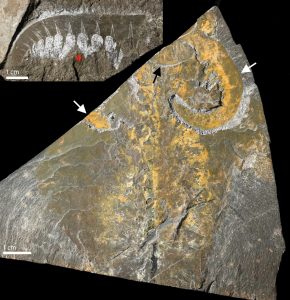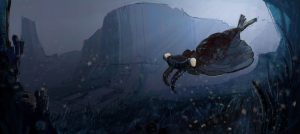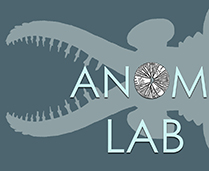Research overview
Much of the research in the ANOM Lab has focused on a particular group of stem-lineage arthropods – Radiodonta – also known informally as the anomalocaridids, based on the first described and most famous taxon of the group, Anomalocaris from the Burgess Shale. Radiodontans were the largest animals during the Cambrian Explosion and are often interpreted as apex predators of these animal communities. Radiodontans have a body with lateral flaps and setal blades, and a head with a pair of sclerotized appendages, circular mouthparts, and a pair of stalked compound eyes. Despite their bizarre appearance, ANOM Lab research has shown that the anatomy of radiodontans represents early evolutionary stages of the anatomical features that define the phylum Arthropoda, including biramous limbs, head shields, cephalic appendages and feeding structures.

In the last 10 years, we have identified multiple new radiodontan taxa and redescribed previously published taxa, such that now over twenty taxa are known globally. Functional morphology analyses of the appendages and mouthparts revealed that not all radiodontan taxa were apex predators, as had always been assumed. While some were active predators, such as Anomalocaris canadensis, others were sweep feeders that fed on whatever could be dredged up from the seafloor sediment. Indeed, some radiodontans were actually filter feeders, which in the Fezouata Biota evolved to have a giant body size, occupying much the same ecological niche as modern day baleen whales. Ongoing work in the ANOM Lab continues to clarify the systematics of Radiodonta in localities such as the USA, China, and Morocco, and will further elaborate on the paleoecology and paleobiogeography of the group.

Research in the ANOM Lab also examines the potential prey items of large apex predators in the Cambrian. Trilobites have long been described as bearing “bite marks”, and we are performing statistical analyses on these damages to determine their origin and cause. We also use quantitative approaches to understand the ecological dynamics of early animal communities in the Cambrian, with similar methods also being applied to understand the enigmatic organisms of the Ediacaran Biota.
Key publications
- Pates, S., Daley, A.C., Edgecombe, G.D., Cong, P. & Lieberman, B.S. 2019. Systematics, preservation and biogeography of radiodonts from the southern Great Basin, USA, during the upper Dyeran (Cambrian Series 2, Stage 4). Papers in Palaeontology, 1–28.
- Pates, S. & Daley, A.C. 2019. The Kinzers Formation (Pennsylvania, USA): the most diverse assemblage of Cambrian Stage 4 radiodonts. Geological Magazine 156, 1233–1246.
Pates, S., Daley, A.C. & Butterfield, N.J. 2019. First report of paired ventral endites in a hurdiid radiodont. Zoological Letters 5, 18. - Pates, S., Daley, A.C. & Lieberman, B.S. 2018. Hurdiid radiodontans from the middle Cambrian (Series 3) of Utah. Journal of Paleontology 92, 99-113.
- Pates, S., Bicknell, D.C., Daley, A.C. & Zamora, S. 2017. Quantitative analysis of repaired and unrepaired damage to trilobites from the Cambrian (Stage 4, Drumian) Iberian Chains, Spain. PALAIOS 32, 750-761.
- Cong, P., Daley, A.C., Edgecombe, G.D. & Hou, X. 2017. The functional head of the Cambrian radiodontan (stem-group Euarthropoda) Amplectobelua symbrachiata. BMC Evolutionary Biology 17, 208.
- Cong, P., Daley, A.C., Edgecombe, G.D., Hou, X. & Chen, A. 2016. Morphology of the radiodontan Lyrarapax from the early Cambrian Chengjiang biota. Journal of Paleontology 90, 663-671.
- Van Roy, P., Daley, A.C. & Briggs, D.E.G. 2015. Anomalocaridid trunk limb homology revealed by a giant filter-feeder with paired flaps. Nature 522, 77-80.
- Antcliffe, J.B., Hancy, A.D. & Brasier, M.D. 2015. A new ecological model for the ~565 Ma Ediacaran biota of Mistaken Point, Newfoundland. Precambrian Research 268, 227-242.
- Daley, A.C., Paterson, J.R., Edgecombe, G.D., García?Bellido, D.C. & Jago, J.B. 2013. New anatomical information on Anomalocaris from the Cambrian Emu Bay Shale of South Australia and a reassessment of its inferred predatory habits. Palaeontology 56, 971-990.
- Daley, A.C. & Budd, G.E. 2010. New anomalocaridid appendages from the Burgess Shale, Canada. Palaeontology 53, 721-738.
